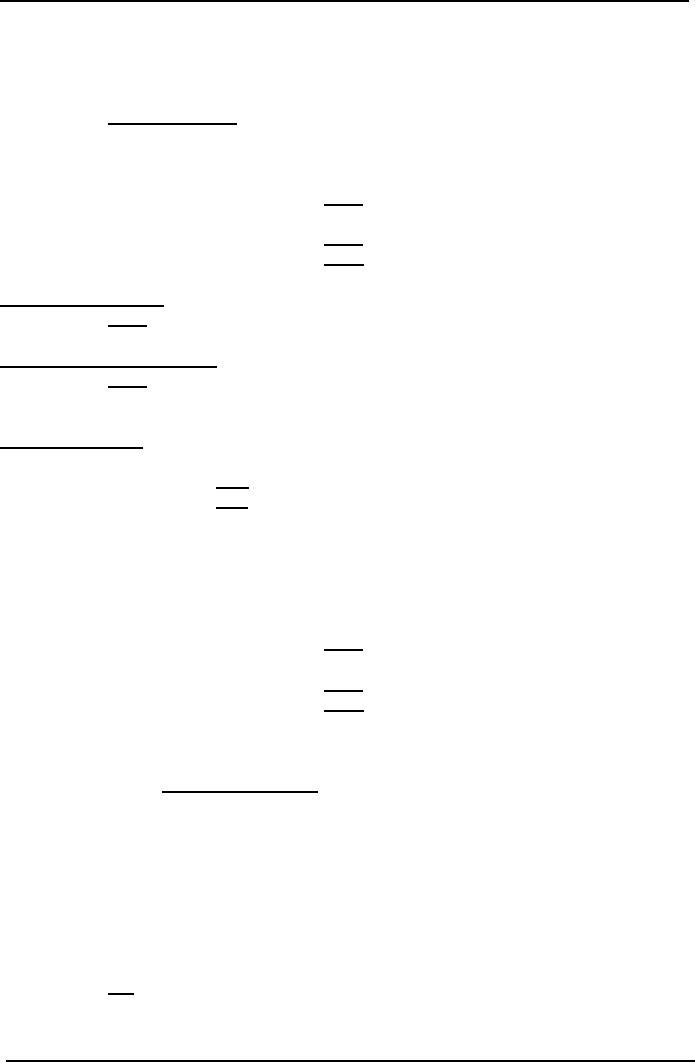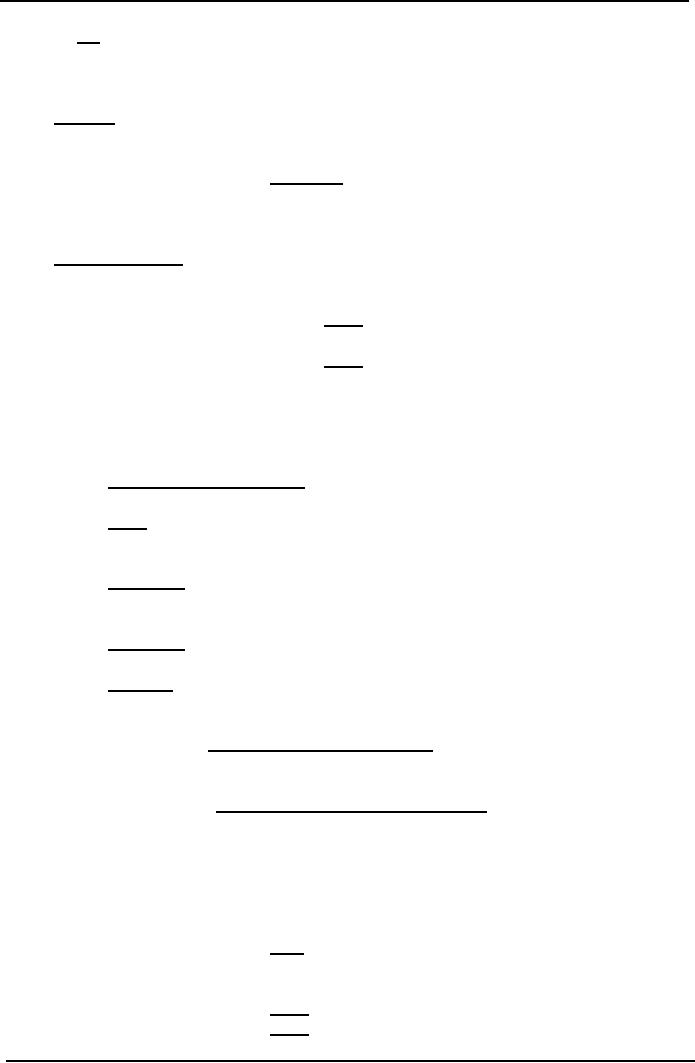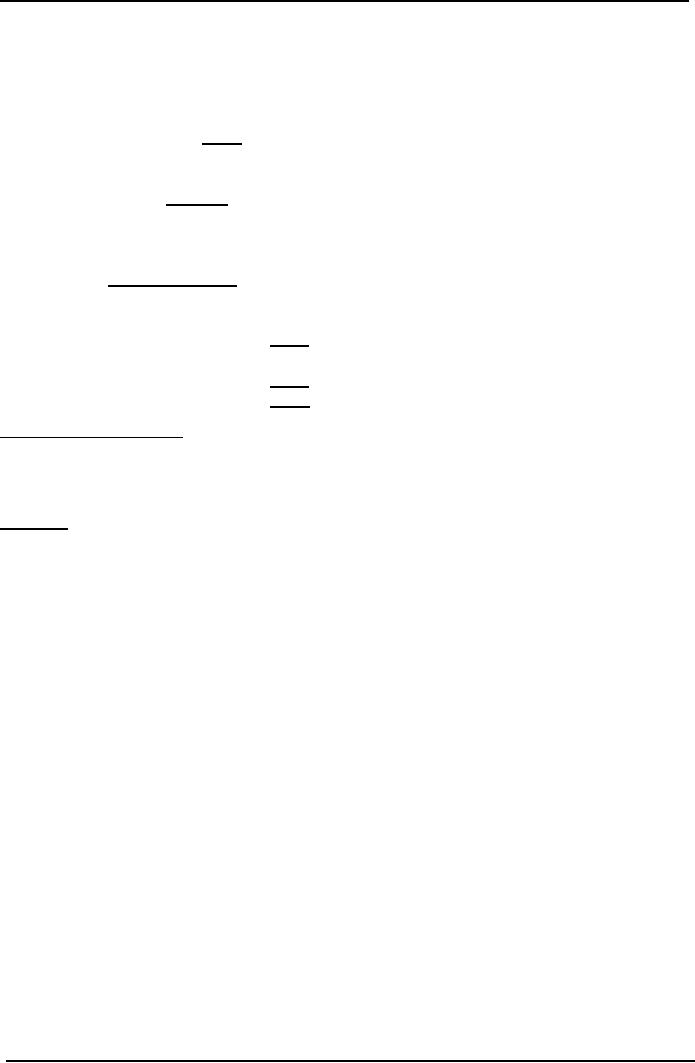 |

Cost
& Management Accounting
(MGT-402)
VU
LESSON#
30
COST
VOLUME PROFIT
ANALYSIS
(Break-even
Approach)
Break-even
Cost-volume-profit
analysis can be used to
calculate break-even.
Break-even
is the point where sales revenue
equals total cost, i.e.
(here is neither a profit
nor a loss.
Profit
(or loss) is the difference
between contribution margin
and fixed costs.
Thus
the break-even point occurs where
contribution margin equals
fixed costs
Target
Contribution Margin
Target
contribution margin is the
amount which if equal to
fixed cost will give
nil net profit,
whereas,
if we need to earn a target
profit, such profit will be
added up into the fixed
cost to have
target
contribution margin.
Contribution
margin per unit can be
assumed to be constant for
all levels of output in the
relevant
range.
Similarly, fixed costs can
be assumed to be a constant amount in
total.
The
relationships may be depicted
thus:
Contribution
Margin per unit
Selling
price per unit less
variable
costs per unit
Total
contribution
Volume
x (Selling price per unit
less
variable
costs per unit)
Target
Contribution Margin
Fixed
costs + Profit target
Target
Sales in number of units
Target
Contribution Margin
Unit
contribution
Contribution
may be calculated in total, or on a
per-unit basis using selling prices
and variable costs
per
unit.
The
difference between contribution and
fixed costs is profit (or
loss); thus when
contribution
equals
fixed costs, break-even occurs. In
this way a target profit may
be converted into a
target
contribution
margin which may be used to
calculate the number of
units required to achieve
the
desired
target profit.
Contribution
margin to sales
ratio
Contribution
to sales ratio (C/S ratio)
=
Contribution
Margin in Rs
Sales
in Rs
Note:
you may encounter the
term profit to volume (or
P/V) ratio, which is
synonymous with the
contribution
to sales ratio. Profit to
volume is an inaccurate description,
however, and should
not
be
used. The C/S ratio is
conveniently written as a
percentage.
Break
even point refers to the
volume (sales) at which the
entity earns no profit and
suffers no
loss.
It
is the point where
Contribution
margin = Fixed cost
And
Target
profit = 0
Contribution
margin Fixed cost = 0
Profit
Contribution
margin = Fixed cost + 0
Profit
At
break even point the
target contribution is equal to
the fixed cost
Contribution
Margin Fixed cost =
Profit
185

Cost
& Management Accounting
(MGT-402)
VU
Contribution
margin = Fixed cost +
Profit
Practice
Question
Q.
1
Income
Statement
Rs.
Sales
700
units x Rs 8
5,600
Variable
cost 700 units x Rs 6
4,200
Contribution
margin
1,400
Fixed
cost
1,000
Profit
400
Variable
cost over sales
4,200
x 100 = 75%
5,600
Contribution
margin over sales
1,400
x 100 = 25%
5,600
Per
Unit Calculation
Sales
price
Rs
8
Less
Variable cost
(6)
Contribution
Margin
2
6
/ 8 x 100 = 75%
2
/ 8 x 100 = 25%
Total
per
unit
%
Sales
700
units x Rs 8
5,600
8
100%
Variable
cost 700 units x Rs 6
4,200
6
75%
Contribution
margin
1,400
2
25%
Fixed
cost
1,000
Profit
400
Break
even sales in
Rupees
Remember
the formula to calculate required
amount in absence of certain
information:
Given
Amount x
%
of required amount =
Required
Amount
%
of given amount
Here,
to calculate break even
sale, we need contribution
margin to be equal to the
fixed cost so
that
the profit is zero.
Now
if the target contribution
margin is equal to Rs. 1,000
then what would be the
sales at this
point?
Now
the above formula will be
applied to calculate breakeven
sales:
Target
CM is the given amount and its % is
25, so the sale which is
100% will be:
Rs
1,000 x
100
= Rs 4,000
25
OR
186

Cost
& Management Accounting
(MGT-402)
VU
Rs
1,000 x 1 =
Rs.
4,000
25
OR
Rs
1,000 =
Rs.
4,000
25
So,
Break
even Sales in Rs. =
Fixed
cost
C/S
ratio
Check
Income
Statement
Rs.
Sales
500
units x Rs 8
4,000
Variable
cost 500 units x Rs 6
3,000
Contribution
margin
1,000
Fixed
cost
1,000
Profit
0
Break
even sales in units
Simple
formula:
Break
even sales in Rupees =
number of units
Sales
price per unit
4,000
= 500 units
8
Direct
formula
Target
CM
CM
per unit
Here
the target contribution
margin is equal to the
fixed
Fixed
Cost
CM
per unit
Rs.
1,000
=
500 units
2
Break
even sales in Rupees
=
Target
CM
Contribution
to sales ratio
Break
even sales in units=
Target
CM
Contribution
margin per unit
Q.
2
Calculate
Sales to target profit of
Rs. 500, using the
information given in practice question
no. 1.
Sales
***
Variable
cost
(***)
Contribution
margin
***
Fixed
cost
1,000
Profit
500.
187

Cost
& Management Accounting
(MGT-402)
VU
Target
contribution margin = Fixed cost +
Target profit
=
1,000
+
500
=
1,500
Sales
to earn target profit of Rs.
500
=
Rs 1,500 x 100 = Rs.
6,000
25
=
Rs
1,500 = Rs. 6,000
0.25
Check
Income
Statement
Rs.
Sales
6,000
Less
Variable cost
4,500
Contribution
Margin
1,500
Less
Fixed cost
1,000
Profit
500
Fixed
cost + Target profit
Contribution
to sales ratio
Problem
Question
A
company sold fans at Rs 2,000 each.
Variable cost Rs. 1,200 each
and fixed cost Rs.
610,000.
Calculate:
a.
Calculate break even sales
in Rupees.
b.
Break even sales in
units.
c.
Sales in units to earn a
profit of Rs. 20,000.
Multiple
Choice Questions
The
following details relate to a shop
which currently sells 25,000
pairs of shoes
annually.
Selling
price per pair of
shoes
Rs.40
Purchase
cost per pair of
shoes
Rs.25
Total
annual fixed costs
Rs.
Salaries
100,000
Advertising
40,000
Other
fixed expenses
100,000
Q.
1
What
is the contribution per pair
of shoes?
A
Rs.15
B
Rs.30
C
Rs.7.50
D
Rs.18
Q.
2
What
is the break-even number of
pairs of shoes?
A
14,000
B
16,000
C
28,000
D
32,000
188
Table of Contents:
- COST CLASSIFICATION AND COST BEHAVIOR INTRODUCTION:COST CLASSIFICATION,
- IMPORTANT TERMINOLOGIES:Cost Center, Profit Centre, Differential Cost or Incremental cost
- FINANCIAL STATEMENTS:Inventory, Direct Material Consumed, Total Factory Cost
- FINANCIAL STATEMENTS:Adjustment in the Entire Production, Adjustment in the Income Statement
- PROBLEMS IN PREPARATION OF FINANCIAL STATEMENTS:Gross Profit Margin Rate, Net Profit Ratio
- MORE ABOUT PREPARATION OF FINANCIAL STATEMENTS:Conversion Cost
- MATERIAL:Inventory, Perpetual Inventory System, Weighted Average Method (W.Avg)
- CONTROL OVER MATERIAL:Order Level, Maximum Stock Level, Danger Level
- ECONOMIC ORDERING QUANTITY:EOQ Graph, PROBLEMS
- ACCOUNTING FOR LOSSES:Spoiled output, Accounting treatment, Inventory Turnover Ratio
- LABOR:Direct Labor Cost, Mechanical Methods, MAKING PAYMENTS TO EMPLOYEES
- PAYROLL AND INCENTIVES:Systems of Wages, Premium Plans
- PIECE RATE BASE PREMIUM PLANS:Suitability of Piece Rate System, GROUP BONUS SYSTEMS
- LABOR TURNOVER AND LABOR EFFICIENCY RATIOS & FACTORY OVERHEAD COST
- ALLOCATION AND APPORTIONMENT OF FOH COST
- FACTORY OVERHEAD COST:Marketing, Research and development
- FACTORY OVERHEAD COST:Spending Variance, Capacity/Volume Variance
- JOB ORDER COSTING SYSTEM:Direct Materials, Direct Labor, Factory Overhead
- PROCESS COSTING SYSTEM:Data Collection, Cost of Completed Output
- PROCESS COSTING SYSTEM:Cost of Production Report, Quantity Schedule
- PROCESS COSTING SYSTEM:Normal Loss at the End of Process
- PROCESS COSTING SYSTEM:PRACTICE QUESTION
- PROCESS COSTING SYSTEM:Partially-processed units, Equivalent units
- PROCESS COSTING SYSTEM:Weighted average method, Cost of Production Report
- COSTING/VALUATION OF JOINT AND BY PRODUCTS:Accounting for joint products
- COSTING/VALUATION OF JOINT AND BY PRODUCTS:Problems of common costs
- MARGINAL AND ABSORPTION COSTING:Contribution Margin, Marginal cost per unit
- MARGINAL AND ABSORPTION COSTING:Contribution and profit
- COST – VOLUME – PROFIT ANALYSIS:Contribution Margin Approach & CVP Analysis
- COST – VOLUME – PROFIT ANALYSIS:Target Contribution Margin
- BREAK EVEN ANALYSIS – MARGIN OF SAFETY:Margin of Safety (MOS), Using Budget profit
- BREAKEVEN ANALYSIS – CHARTS AND GRAPHS:Usefulness of charts
- WHAT IS A BUDGET?:Budgetary control, Making a Forecast, Preparing budgets
- Production & Sales Budget:Rolling budget, Sales budget
- Production & Sales Budget:Illustration 1, Production budget
- FLEXIBLE BUDGET:Capacity and volume, Theoretical Capacity
- FLEXIBLE BUDGET:ANALYSIS OF COST BEHAVIOR, Fixed Expenses
- TYPES OF BUDGET:Format of Cash Budget,
- Complex Cash Budget & Flexible Budget:Comparing actual with original budget
- FLEXIBLE & ZERO BASE BUDGETING:Efficiency Ratio, Performance budgeting
- DECISION MAKING IN MANAGEMENT ACCOUNTING:Spare capacity costs, Sunk cost
- DECISION MAKING:Size of fund, Income statement
- DECISION MAKING:Avoidable Costs, Non-Relevant Variable Costs, Absorbed Overhead
- DECISION MAKING CHOICE OF PRODUCT (PRODUCT MIX) DECISIONS
- DECISION MAKING CHOICE OF PRODUCT (PRODUCT MIX) DECISIONS:MAKE OR BUY DECISIONS